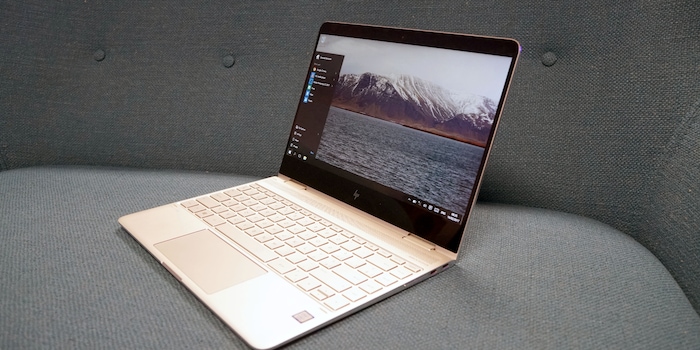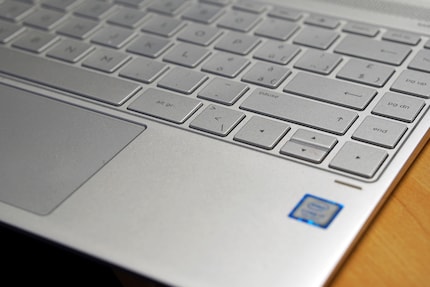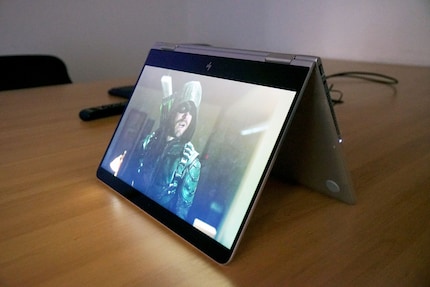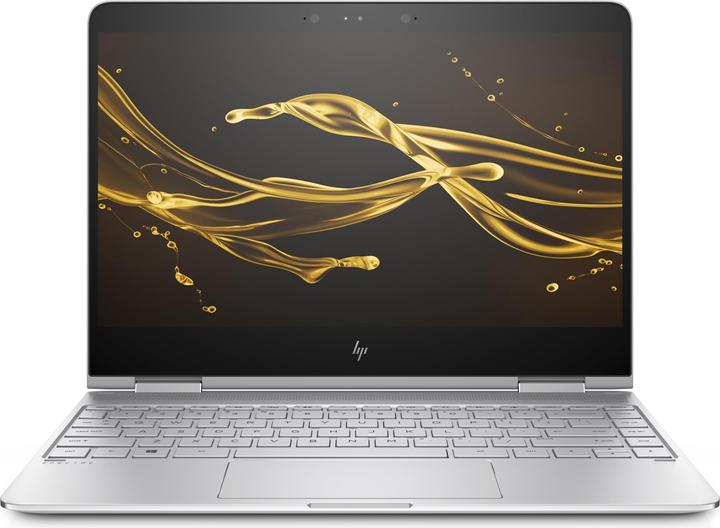

HP Spectre x360 13-w090nz - A laptop as invented by Q
James Bond and his adversaries have always known how to put themselves in the limelight. Only the best is good enough for them. Since the latest Bond film "Spectre", a laptop has even been named after the secret organisation of international villains. However, it is so versatile in terms of its use that it could easily have come from the scientist Q.
I'm more of a coarse motorist and I like large screens. That's why laptops with a screen size of less than 15 inches have simply been too small for me so far. But my current year will be characterised by longer trips. So I need something that fits easily into my hand luggage, is light and still delivers performance. A visit to the office of Category Manager Remo Pascale should help me with this.
He thinks for a moment, as he has recently been looking into convertibles. These devices are not just laptops, but also tablets. The screen can be turned completely around the device, the keyboard is deactivated, Windows 10 switches to tablet mode and users can turn their laptop into a tablet in a single movement. But he is undecided. Which model should it be? Because there are currently three models on the market that not only offer a lot of performance but are also similar apart from a few minor details.
One of them is the HP Spectre x360 13-w090nz, referred to below simply as Spectre because the rest of the name is quite clunky.

Update 13/07/2017: Marketing manager Anadi Singh has informed me that my beloved Spectre is end-of-life. This means that I should recommend its successor to you. The successor is a solid upgrade in terms of specs and so I'm linking to the article now. Because if the successor is even half as good as its predecessor, then you'll have a lot of fun with it.
Does the world need a new laptop?
The promotional video sounds a bit pompous and somewhere after the first minute of "artisans" and "anodised aluminium for the noble" I stopped listening. But the question "Does the world need a new laptop?" sticks with me.
Because the thing is, laptops have somehow fallen off the radar of the tech scene. Sure, one comes out every now and then and they're always okay, but somehow the small-format computers never get the attention that a new iPhone or a tablet from a big company gets. The latest disappointment was when the new Macbook Pro was unveiled and its manufacturer Apple has obviously forgotten what business devices are all about. Comfort and slimness are sacrificed in favour of versatility and, above all, connections of all kinds. The new Macbook does not fulfil this requirement. That's why many Mac users are now looking for something new. If I need a laptop, I don't bother with it until I want to buy one. Smartphones, on the other hand, are on my radar and my newsfeed keeps me informed about new developments.
That's a shame, because the Spectre and its competitors are quickly reinventing a device that others have long since declared dead.
Touchscreen makes life easier
The HP Spectre combines the best qualities of a tablet and a laptop in standard laptop mode. In particular, the finesse of a tablet touchscreen has been mounted on top of a keyboard, if I may put it so crudely. That kills two birds with one stone.
- On a tablet, nobody can write a decent text in a reasonable amount of time
- On a trackpad, I always have to fiddle around for ages until I get what I want
It's amazing how quickly I got used to the touchscreen. It not only supports scrolling and clicking, but also a number of gestures. I used the zoom effect and the "Back" navigation command the most. The fact that I also have the keyboard makes the Spectre an impressive working device. I can type quickly, navigating the operating system is extremely easy and it feels much more natural than if I had swiped around on the trackpad. This has eliminated one of the biggest shortcomings of laptops.

Another shortcoming is the somewhat strange keyboard layout that some laptops have. Because where space needs to be saved, keyboard designers get creative. On the Lenovo Yoga 910, the up arrow key is where I would expect the right SHIFT key to be. For reasons of space. When tested, this always annoyed me extremely. Fortunately, the HP Spectre doesn't have this problem. The up and down arrow keys are simply half as high and so SHIFT on the right remains intact.
No moving parts, no waiting time
The HP Spectre is powered by the latest Kaby Lake processor generation, which promises not only speed but also optimal utilisation of system resources. However, processor speed is only relevant if the rest of the system can keep up. However, since the developers of the Spectre sat down and designed the device with the laptop mindset of "Individual parts are not replaced. If they do, then the whole device is replaced", the laptop is extremely fast on the move.
Starting up from cold to Windows login takes a maximum of seven seconds. This is not only due to the processor or the 16GB RAM, but also to the 1000GB solid state disc (SSD), which reads and writes at speeds of over 600MB per second. Waiting times are a thing of the past.
In short, the HP Spectre is a pleasure to employ, even if I wasn't initially convinced as a fan of large screens. Because 13.3 inches was a bit small for me. But the picture is also razor-sharp, even if prophets of doom say that the laptop fails. That's because the Spectre can't achieve 4k resolution. That's a shame, but it doesn't make the Spectre uncompetitive.
Tablet mode useless with a but
One thing I couldn't really get used to was the tablet mode, as it suffers from the typical symptoms of tablets: they are simply not useful. As a media consumption device, tablets are nice, fun and good, but any interaction with productivity as a goal feels limited and cumbersome when it goes beyond navigating the operating system and simple commands.
The exciting thing is that the HP Spectre runs on Windows and not Apple's iOS or Android. Think about it: all programmes, or apps, that run on Windows are now seamlessly accessible on a tablet. Even though I rarely used tablet mode, I appreciated not having to make any compromises in terms of applications.
One example: Chrome is also fully functional in Windows 10 tablet mode and is closer to the full-screen original than the somewhat more cumbersome and slimmed-down Android version.
The handling of the Spectre in tablet mode is also interesting. The keyboard remains haptically intact. This means that I can still press buttons with the hand holding the tablet. Fortunately, the keyboard is deactivated when it is folded down, otherwise I would be typing nonsense line by line. Although I know this in my head, I was startled again and again during the test phase because I accidentally pressed some buttons and instinctively thought I had written some nonsense.
Windows has potential
At this point, I would like to make a small digression and briefly write down my thoughts on Windows as an operating system. Because writing a separate article from the two following sections seems to me to be a waste at the moment.
Windows, as the Spectre shows, also has massive potential as a mobile and flexible platform and I hope that Microsoft can shake off its dusty image here too and become an innovator. Because since around the beginning of the Surface era, the company has shown that it has what it takes.
This is exciting because the Surface Studio is a product that is drastically changing the way people use computers and Windows 10 remains dynamic. If the operating system can establish itself as a versatile platform, then a new golden era for Windows could be on the horizon.
The conclusion

The HP Spectre x360 is versatile, fast, beautiful to look at and lightweight. Not only is it the perfect laptop for travellers, but it also packs a fully functioning tablet into the same device. Even if using it in tablet mode is a little strange, the tent mode (see picture) is useful and convenient for watching films on the plane or YouTube videos on the bedside table.
Journalist. Author. Hacker. A storyteller searching for boundaries, secrets and taboos – putting the world to paper. Not because I can but because I can’t not.


